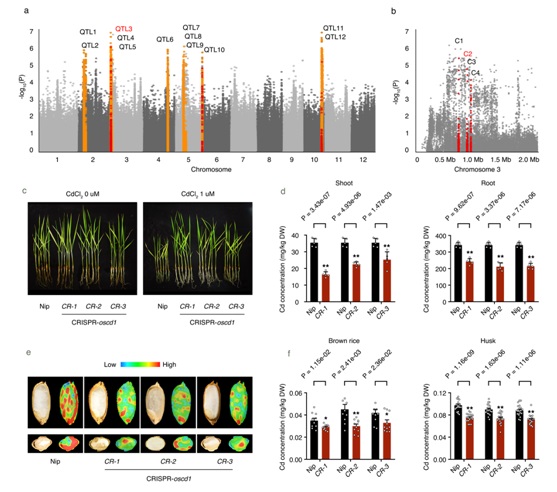Rice is the major component of diet for over half of the population in China. However, cadmium (Cd), which is a kind of toxic heavy metal, can be easily absorbed and enriched in rice, and then enters the human body through the food chain, thus threatening human health.
In recent years, cadmium pollution has become a serious problem, especially in the southern paddy fields of China. Asian cultivated rice is divided into two subspecies, indica and japonica. Indica rice is mainly cultivated in southern of China and is the main food in these regions. Generally, indica rice can accumulate more cadmium than japonica rice, suggesting the reason of excessive cadmium in southern rice.
Thus, identifying the low-Cd accumulation genes and loci responsible for rice varietal differences and reducing rice Cd accumulation, especially indica rice, have become keys for safety rice cultivation.
The Research Group led by Dr. Zhenyan He from the Key Laboratory of Plant Resources, Institute of Botany, Chinese Academy of Sciences and their collaborators successfully identified and characterized a rice grain Cd accumulation related gene OsCd1 by using the genome-wide association study (GWAS) technology, gene annotation system and yeast/rice functional verification system.
OsCd1 belonging to major facilitator superfamily (MFS) was characterized as a secondary active Cd transporter gene in rice. OsCd1 was a plasma membrane protein in root and the disruption of OsCd1 resulted in a decrease of Cd accumulation in rice, indicating OsCd1 may mediate the Cd uptake in rice root and, ultimately, contribute to grain cadmium accumulation.
Moreover, the natural variation in OsCd1 with a missense mutation Val449Asp is responsible for the divergence of rice grain Cd accumulation between indica and japonica. Near-isogenic line tests confirm that the indica variety carrying the japonica allele OsCd1V449 can reduce the grain Cd accumulation. Thus, the japonica allele OsCd1V449 may be useful for reducing grain Cd accumulation of indica rice cultivars through breeding.
Collectively, this study has revealed the molecular mechanism of OsCd1 in rice Cd absorption and accumulation and identified a low-Cd related molecular module OsCd1V449, which will offer potential genetic basis for low-Cd rice cultivation especially in indica cultivars.
The study entitled " Variation of a major facilitator superfamily gene contributes to differential cadmium accumulation between rice subspecies" has been published in Nature Communication.
This work was supported by the grants from Chinese Academy of Sciences, the Ministry of Science and Technology of China, China Postdoctoral Science Foundation and Innovation Training Programs for Undergraduates, CAS.

Genome-wide association analysis of rice grain Cd accumulaion and the functional characterization of OsCd1
Article link: https://www.nature.com/articles/s41467-019-10544-y
CONTAC INFO:
Institute of Botany, Chinese Academy of Sciences,
20 Nanxincun, Xiangshan, Beijing 100093, China
E-mail: Int_office@ibcas.ac.cn
Rice is the major component of diet for over half of the population in China. However, cadmium (Cd), which is a kind of toxic heavy metal, can be easily absorbed and enriched in rice, and then enters the human body through the food chain, thus threatening human health.
In recent years, cadmium pollution has become a serious problem, especially in the southern paddy fields of China. Asian cultivated rice is divided into two subspecies, indica and japonica. Indica rice is mainly cultivated in southern of China and is the main food in these regions. Generally, indica rice can accumulate more cadmium than japonica rice, suggesting the reason of excessive cadmium in southern rice.
Thus, identifying the low-Cd accumulation genes and loci responsible for rice varietal differences and reducing rice Cd accumulation, especially indica rice, have become keys for safety rice cultivation.
The Research Group led by Dr. Zhenyan He from the Key Laboratory of Plant Resources, Institute of Botany, Chinese Academy of Sciences and their collaborators successfully identified and characterized a rice grain Cd accumulation related gene OsCd1 by using the genome-wide association study (GWAS) technology, gene annotation system and yeast/rice functional verification system.
OsCd1 belonging to major facilitator superfamily (MFS) was characterized as a secondary active Cd transporter gene in rice. OsCd1 was a plasma membrane protein in root and the disruption of OsCd1 resulted in a decrease of Cd accumulation in rice, indicating OsCd1 may mediate the Cd uptake in rice root and, ultimately, contribute to grain cadmium accumulation.
Moreover, the natural variation in OsCd1 with a missense mutation Val449Asp is responsible for the divergence of rice grain Cd accumulation between indica and japonica. Near-isogenic line tests confirm that the indica variety carrying the japonica allele OsCd1V449 can reduce the grain Cd accumulation. Thus, the japonica allele OsCd1V449 may be useful for reducing grain Cd accumulation of indica rice cultivars through breeding.
Collectively, this study has revealed the molecular mechanism of OsCd1 in rice Cd absorption and accumulation and identified a low-Cd related molecular module OsCd1V449, which will offer potential genetic basis for low-Cd rice cultivation especially in indica cultivars.
The study entitled " Variation of a major facilitator superfamily gene contributes to differential cadmium accumulation between rice subspecies" has been published in Nature Communication.
This work was supported by the grants from Chinese Academy of Sciences, the Ministry of Science and Technology of China, China Postdoctoral Science Foundation and Innovation Training Programs for Undergraduates, CAS.

Genome-wide association analysis of rice grain Cd accumulaion and the functional characterization of OsCd1
Article link: https://www.nature.com/articles/s41467-019-10544-y
Institute of Botany, Chinese Academy of Sciences,
20 Nanxincun, Xiangshan, Beijing 100093, China
E-mail: Int_office@ibcas.ac.cn
